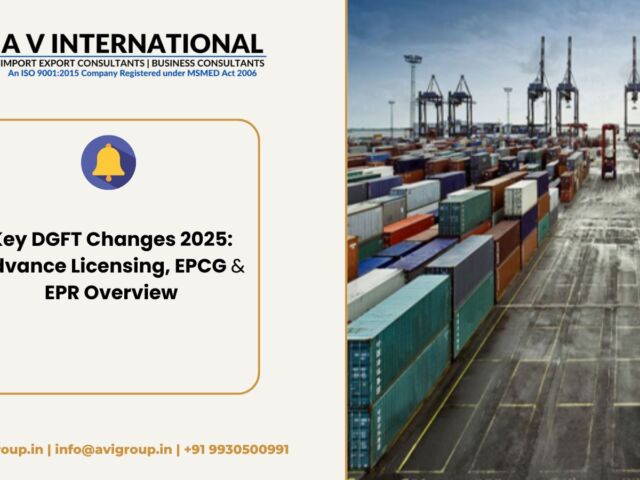Export Promotion Capital Goods Scheme 2025
1. What is the EPCG Scheme?
The Export Promotion of Capital Goods (EPCG) Scheme is a duty-exemption incentive under the DGFT / Foreign Trade Policy framework that allows businesses in India to import capital goods (machinery, equipment, spares) at zero customs duty, subject to fulfilling a specified export obligation. According to your original write-up:
EPCG Scheme allows import of capital goods at zero rates of customs duty, subject to an export obligation that is equivalent to 6 times the duty saved on capital goods, to be fulfilled within 6 years from the date of authorization.
The main aim: to help Indian exporters reduce cost, upgrade technology, and stay competitive globally.
2. Who is Eligible?
Eligibility under EPCG includes:
Manufacturer exporters, with or without supporting / tied-up manufacturers
Merchant exporters, tied up with supporting manufacturer(s)
Service exporters, subject to conditions
For new exporters (with no prior export history), the requirement for “average export obligation” is waived (i.e. their AEO is zero) so they can still utilize the scheme.
3. Key Benefits & Duty Exemptions
Under EPCG, you get duty exemption on:
Basic Customs Duty (BCD)
Additional duties under subsections (1), (3), (5) of the Customs Tariff Act, 1975
IGST (note: IGST benefit applicability under older policies)
Because you import capital goods without paying duty up front, your input costs reduce significantly.
4. Export Obligation (EO) & Average Export Obligation (AEO)
These are the two critical conditions you must satisfy.
Specific Export Obligation (EO): You must export goods — typically, six times the duty saved value of the capital goods imported — within a period of 6 years.
Average Export Obligation (AEO): Over and above the specific EO, your average export performance over the 3 preceding financial years must be maintained (except for new exporters for whom AEO is nil).
If you don’t fulfill AEO, you may have to pay back the duty saved with interest, even if you satisfied EO.
Some product categories (handicrafts, handlooms, certain agriculture, etc.) are exempt from AEO requirements under policy provisions.
5. Procedure to Get an EPCG License
Here’s how you apply:
Online Application on DGFT portal
Apply in the appropriate Regional Authority (RA) of DGFT, using DSC / digital signature.Document Submission
You’ll upload required documents (company incorporation, financials, past export data, capital goods specifications, etc.).Issue of Authorization
DGFT will issue an EPCG License / Authorization after scrutiny.Registering EPCG with Customs
You must register the license with the customs port of import, so that duty-free clearance is allowed.Import & Installation
After customs clearance, you must install the machinery within 6 months and obtain an Installation Certificatefrom an independent Chartered Engineer or customs authority.
6. When Does a Shipment Get Counted Toward EO?
For your export shipments to count:
The EPCG License number must be mentioned in the Shipping Bill.
The exported product (HS code) must match what is authorized in the license.
You can import capital goods BOTH from overseas and domestically (via invalidation letter for indigenous procurement).
Even shipments under other schemes (Advance License, DFIA, MEIS) can count toward your EO provided the EPCG license number is quoted in those shipping bills.
7. Amendments, Revalidation & Invalidation
Amendments: You can modify the license (change CIF value, add new machines or additional products) after issue.
Revalidation: If import validity (2 years) is about to expire, you can apply for extension (commonly extension for 2 more years) under conditions.
Invalidation (Domestic Sourcing): If you procure certain machinery locally rather than importing, you can apply for invalidation, which reduces EO by some portion (often 25%) and allows you to pay only notional duty.
8. Redemption / Closure of EPCG License
Once EO is fulfilled, you apply for redemption using form ANF 5B, submitting all proofs (shipping bills, invoices, installation certificate, EO discharge certificate). DGFT then issues an Export Obligation Discharge Certificate (EODC), formally closing your license.
9. Consequences & Penalties for Default
If Specific EO not fulfilled → Pay the duty saved + 15% yearly interest on the pending amount.
If Average EO not fulfilled → Pay duty + interest, even if Specific EO is fulfilled.
If both fail → Possibility of license cancellation, demand for duty recovery, and restrictions on obtaining future benefits.
10. Strategic Considerations & Best Practices
Apply EPCG only if you have adequate export flows to meet the EO — else the risk is high.
Use machinery for goods you are confident exporting.
Monitor your average export history to avoid AEO defaults.
Plan carefully on which shipments to count, and ensure Shipping Bills properly quote EPCG number.
Always maintain perfect documentation — invoices, manifests, installation certs.
Early fulfillment of EO (e.g. shipping earlier than deadline) may allow redemption benefits under policy (some policies give incentives).
DGFT
Legal
Company Secretarial
DGFT Notifications
Others
Recent Posts
- Top Export Compliance Mistakes: DGFT Advance Authorization, EPCG & CPCB (2025 Guide)
- Environmental Clearance CPCB Quick Guide for Exporters
- DGFT e-BRC Rule 2025: Key Update for Advance Authorization & EPCG Holders
- Key DGFT Changes 2025: Advance Licensing, EPCG & EPR Overview
- DGFT 2025 Updates: Key Changes for Advance Authorization License & EPCG Authorization Licence Holders
- DGFT Notifies 3 New SIONs: A-3690, A-3691 & A-3692
- DGFT allocates 5841 MT for Sugar Export
- DGFT Eases Export Rules for Pharma Grade Sugar – Key Changes in ANF-2N Form
featured articles
Top Export Compliance Mistakes: DGFT Advance Authorization, EPCG & CPCB (2025 Guide) Exporting in India can feel like a legal…
Environmental Clearance CPCB: Quick Guide for Exporters If you’re an Indian exporter or manufacturer working under schemes like the Advanced…
DGFT e-BRC Rule 2025: Key Update for Advance Authorization & EPCG Holders The Directorate General of Foreign Trade (DGFT) has…
Key DGFT Changes 2025: Advance Licensing, EPCG & EPR Overview DGFT Updates 2025: What Exporters and Importers Should Know About…





